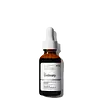What's inside
What's inside
 Key Ingredients
Key Ingredients

 Benefits
Benefits

 Concerns
Concerns

No concerns
 Ingredients Side-by-side
Ingredients Side-by-side

Water
Skin ConditioningGlycerin
HumectantCaprylic/Capric Triglyceride
MaskingEthyl Linoleate
EmollientPropanediol
SolventDimethyl Isosorbide
SolventCetearyl Isononanoate
EmollientBisabolol
MaskingHydroxypinacolone Retinoate
Skin ConditioningRetinol
Skin ConditioningTasmannia Lanceolata Fruit/Leaf Extract
AntioxidantInulin Lauryl Carbamate
Emulsion StabilisingGlyceryl Stearate
EmollientCeteareth-12
EmulsifyingCeteareth-20
CleansingCetearyl Alcohol
EmollientCarrageenan
Xanthan Gum
EmulsifyingAcacia Senegal Gum
MaskingCetyl Palmitate
EmollientSucrose Laurate
EmollientPolysorbate 20
EmulsifyingIsoceteth-20
EmulsifyingRosmarinus Officinalis Leaf Extract
AntimicrobialHydroxymethoxyphenyl Decanone
Skin ConditioningBehentrimonium Chloride
PreservativeTrisodium Ethylenediamine Disuccinate
Disodium EDTA
Dehydroacetic Acid
PreservativeBenzoic Acid
MaskingEthylhexylglycerin
Skin ConditioningPhenoxyethanol
PreservativeChlorphenesin
AntimicrobialWater, Glycerin, Caprylic/Capric Triglyceride, Ethyl Linoleate, Propanediol, Dimethyl Isosorbide, Cetearyl Isononanoate, Bisabolol, Hydroxypinacolone Retinoate, Retinol, Tasmannia Lanceolata Fruit/Leaf Extract, Inulin Lauryl Carbamate, Glyceryl Stearate, Ceteareth-12, Ceteareth-20, Cetearyl Alcohol, Carrageenan, Xanthan Gum, Acacia Senegal Gum, Cetyl Palmitate, Sucrose Laurate, Polysorbate 20, Isoceteth-20, Rosmarinus Officinalis Leaf Extract, Hydroxymethoxyphenyl Decanone, Behentrimonium Chloride, Trisodium Ethylenediamine Disuccinate, Disodium EDTA, Dehydroacetic Acid, Benzoic Acid, Ethylhexylglycerin, Phenoxyethanol, Chlorphenesin
Water
Skin ConditioningOryza Sativa Bran Oil
EmollientDimethyl Isosorbide
SolventGlycerin
HumectantHydroxypinacolone Retinoate
Skin ConditioningErgothioneine
AntioxidantSodium Hyaluronate
HumectantSodium Gluconate
Skin ConditioningCaprylyl Glycol
EmollientHydrogenated Phosphatidylcholine
EmulsifyingSclerotium Gum
Emulsion StabilisingPolyacrylate Crosspolymer-6
Emulsion StabilisingDehydroxanthan Gum
Emulsion StabilisingPhenoxyethanol
PreservativeSodium Hydroxide
BufferingCitric Acid
BufferingWater, Oryza Sativa Bran Oil, Dimethyl Isosorbide, Glycerin, Hydroxypinacolone Retinoate, Ergothioneine, Sodium Hyaluronate, Sodium Gluconate, Caprylyl Glycol, Hydrogenated Phosphatidylcholine, Sclerotium Gum, Polyacrylate Crosspolymer-6, Dehydroxanthan Gum, Phenoxyethanol, Sodium Hydroxide, Citric Acid
 Reviews
Reviews

Ingredients Explained
These ingredients are found in both products.
Ingredients higher up in an ingredient list are typically present in a larger amount.
Dimethyl Isosorbide is a solvent and helps deliver actives into your skin. It is created from sorbitol.
As a solvent, dimethyl isosorbide helps dissolve other ingredients. This helps ensure even distribution of an ingredient. It may also be used to decrease the thickness of a product.
Studies show dimethyl isosorbide is able to penetrate skin to deliver other ingredients into the skin, making them more effective.
Learn more about Dimethyl IsosorbideGlycerin is already naturally found in your skin. It helps moisturize and protect your skin.
A study from 2016 found glycerin to be more effective as a humectant than AHAs and hyaluronic acid.
As a humectant, it helps the skin stay hydrated by pulling moisture to your skin. The low molecular weight of glycerin allows it to pull moisture into the deeper layers of your skin.
Hydrated skin improves your skin barrier; Your skin barrier helps protect against irritants and bacteria.
Glycerin has also been found to have antimicrobial and antiviral properties. Due to these properties, glycerin is often used in wound and burn treatments.
In cosmetics, glycerin is usually derived from plants such as soybean or palm. However, it can also be sourced from animals, such as tallow or animal fat.
This ingredient is organic, colorless, odorless, and non-toxic.
Glycerin is the name for this ingredient in American English. British English uses Glycerol/Glycerine.
Learn more about GlycerinThis ingredient is a retinoid. It usually goes by a more common name: "Granactive".
Hydroxypinacolone Retinoate (HPR) belongs to the class of retinoids that also includes retinol and tretinoin.
Retinoids have been proven to:
So what is the difference between all the retinoids?
Most retinoids need to go through a conversion line to become effective on skin. The ending product is retinoic acid. Retinoic acid is AKA tretinoin.
HPR is an ester of tretinoin. Emerging studies suggest HPR to have an added benefit that other retinoids don't have: Low irritation.
A study from 2021 found HPR to have the greatest stability when exposed to light and temperature out of all the commercial retinoids.
A note about naming:
The name "Granactive" is the trade name and the name most commonly used on packages.
Granactive is the name of the mixture - about 90% solvent and 10% HPR. A product with 5% granactive has 0.5% HPR.
Learn more about Hydroxypinacolone RetinoatePhenoxyethanol is a preservative that has germicide, antimicrobial, and aromatic properties. Studies show that phenoxyethanol can prevent microbial growth. By itself, it has a scent that is similar to that of a rose.
It's often used in formulations along with Caprylyl Glycol to preserve the shelf life of products.
Water. It's the most common cosmetic ingredient of all. You'll usually see it at the top of ingredient lists, meaning that it makes up the largest part of the product.
So why is it so popular? Water most often acts as a solvent - this means that it helps dissolve other ingredients into the formulation.
You'll also recognize water as that liquid we all need to stay alive. If you see this, drink a glass of water. Stay hydrated!
Learn more about Water